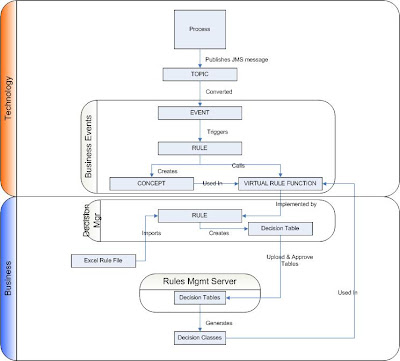
Thursday, December 3, 2009
Tibco Integration Snapshot

Governance.... The key to success
Events repository in its simple form should list all the events, the publisher of the event, a simple definition of the event, the list of subscribers to the event. It can be extended to include the attributes of the event, and the attributes the subcribers are interested in.
Tibco recommends using event attributes instead of payload to improve the performance, hence the more thought given upfront defining the event and the attributes and also ensuring proper checks to avoid duplication of events facilitates successful implementation of EDA.
Likewise, a repository is also required to manage rules. Rules should be organized by domain, rule type to facilitate ease of management. Proper procedures should be in place for change management and rule impact analysis. Defining roles and workflow to manage rules will enhance the checks and balances.
Finally, the collaboration between different domains within the organization holds the key for a successful implementation of enterprise Event Driven Architecture. Establishing proper communication mechanisms between different stake holders and understanding dependencies and relationships among various business processes are also equally important.
Wednesday, December 2, 2009
Tibco BE - Custom UI
Tibco BE - Decision manager
Tuesday, December 1, 2009
Thursday, January 22, 2009
Knowledge Management ……….. Simplified
I was talking to my colleagues the other day and were discussing about the clients we worked so far. In the midst of the discussion I realized that I do not remember some of the patterns I used, the tweaks I made to the code and I had to go back to my documentation that I had with me over the years.
My friend was talking about the issues he was having finding the relevant information he was looking for on the intranet.
My other friend told about his experience as to how much he missed the guidance of a guy who worked for the company for a very long time and had left the company.
The solution is possible if the business treats the knowledge component of business activities as an explicit concern of business reflected in strategy, policy, and practice at all levels of the organization
Requirements of a good KM.
· Workspaces for teams to coordinate schedules, organize documents, and participate in discussions within the organization on the intranet.
· Easily manage documents and ensure their integrity:
o require document checkout before editing
o view and post revisions and restore previous versions
o set document-specific security
o storage capability for multiple Gigabytes of data
· Real-time communication triggers that let others know when their actions or attention is required (i.e. documentation, announcements, sophisticated alerts, surveys, discussion boards).
· Templates for ease of creating:
o Weblogs (blogs)
o Wikis (quickly editable by team members)
· Templates for Discussion Boards / Forums
· Searchable Content within Knowledge Base
· Web enabling of e-mail chains
· User rating of content; ratings should affect searchability of content
I have evaluated MOSS (Microsoft Office SharePoint Server 2007) as a potential tool for KM and I am impressed by the features available.

Tuesday, January 20, 2009
Content Management …………… Simplified
The question is how to give the business owners the ability to make content changes without having to make the changes to the code base.
Let’s go back to our Insurance Company example to illustrate this better.
For the sake of this example let’s assume that all businesses have web interfaces that are consumer facing and the business wants to have a review process in place before the content gets to the consumer.
In a nut shell we need a Workflow.
We need to have clearly defined roles like Author, Reviewer, Approver, Publisher to support the business process of publishing the content.
Now let’s explore how the content is consumed by the departments.
"New Business" consumes the content by directly interacting with the content database, "Renewals" consumes a DLL which is generated say by a batch process which is run twice in a week, "Claims" gets the content via Web Services exposed by the CMS.
Now we not only have inconsistency in terms of how the applications access the content, but also how fast the content is available for application consumption.
Things will get further complicated if the Business decides to expose business process to different delivery channels.
I illustrated this as a cross domain example for the sake of understanding, but the same principle applies to all the applications within the domain that consume content.
So need to not only develop a good Content Model but also a consistent Delivery Model that could address these issues.


